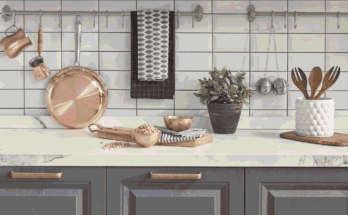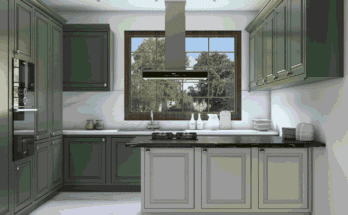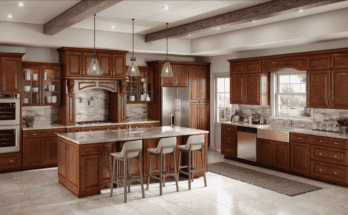1. Introduction
The kitchen is often considered the heart of the home—a space where functionality meets design and where style should reflect personal taste. Two-tone cabinets have become popular for homeowners looking to add character and sophistication to their kitchens. By combining two different colors or finishes, these cabinets create a visually appealing contrast that can enhance the space’s overall design. In this article, we’ll explore why two-tone cabinets are a great choice, how to choose the right combinations, and practical tips for incorporating them into your kitchen.
2. What Are Two-Tone Cabinets?
Defining Two-Tone Cabinets
Two-tone cabinets refer to having different colors or types of finish on different parts of the kitchen. This design style commonly applies one color for the upper cabinets and another for the lower cabinets, depending on whether or not there is a contrasting island with neutral cabinets. You get a three-dimensional look that gives the kitchen the desired appeal and break.
The Growing Popularity
Two-toned cabinets have been making their way into more and more homes as people look to get away from the stereotypical all-cabinetry designs. This design trend gives much freedom and the possibility to metaphorically match the kitchen to the rest of the home’s design. Another factor that may have compounded this trend is the visibility of the kitchen, especially in most open living plans, as it provides a chance to restrict the area and make a statement.
3. Benefits of Two-Tone Cabinets
Adds Visual Interest
Therefore, pieces of furniture with a two-tone appearance look more eye-catching and interesting. To a certain extent, the contrast of different colors or surface textures makes the gaze move in the direction of the contrast, and thus, the kitchen does not look monotonous.
Breaks Up Monotony
It is also important not to overdo a single tone in a kitchen, as it may make the room look dull. This means that when you decide to have two scraper tones, they offer you the next level that helps break the continuity of cabinetry. This approach enables the enhancement of character and depth, which makes the kitchen space most appealing.
Enhances Room Perception
Two-tone cabinets can also play a strategic role in altering the perception of space. For example, using a lighter color on the upper cabinets and a darker color on the lower cabinets can create the illusion of more height, making the room appear larger and more open.
4. Choosing the Right Color Combinations
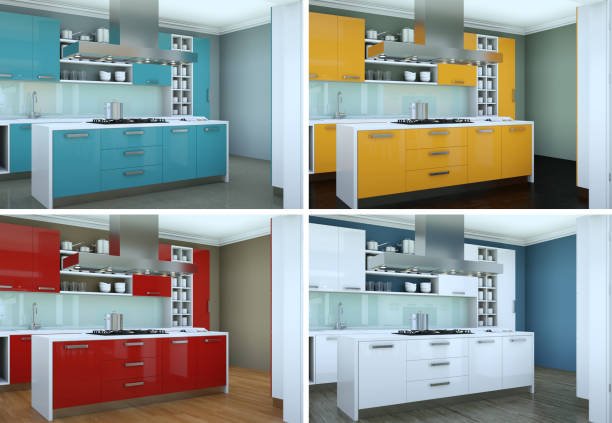
Classic Color Pairs
For a timeless look, consider classic color combinations such as:
- Navy Blue and White: A sophisticated pairing that works well in modern and traditional kitchens alike.
- Gray and Cream: A neutral duo that contrasts soft and elegantly.
These combinations are versatile and can adapt to various design styles without becoming outdated.
Bold and Modern Hues
If you prefer a more contemporary look, bold color combinations can make a strong statement:
- Black and Mustard Yellow: A high-contrast pairing that adds a dramatic flair to modern kitchens.
- Teal and Coral: A vibrant mix that injects energy and personality into the space.
These colors are best used cautiously to avoid overwhelming the room and should be balanced with neutral elements.
Contrasting vs. Complementary Colors
When selecting colors, decide between contrasting or complementary hues:
- Contrasting Colors: Create a striking effect, such as black and white or deep blue and light gray.
- Complementary Colors: Offer a more subtle and harmonious look, such as light blue and soft gray.
Both approaches can be effective, depending on the desired impact and overall design vision.
5. Incorporating Two-Tone Cabinets into Different Kitchen Styles
Modern Kitchens
Two-tone kitchen cabinets, introduced in modern kitchens, are normally characterized by high gloss and blazing colors. One simple design idea is to have the base cabinets painted in a dark hue and the uppers painted in a lighter shade. Materials such as glass or metalwork must be used to support the modern look and feel.
Rustic or Farmhouse Kitchens
While selecting colors for rustic or farmhouse kitchens, they should go for rather gentle and delicate shades, and when it comes to the materials, they should be natural. One trend is to paint the lower cabinets and leave the upper ones of natural wood. Both of these features complement each other and introduce warmth and personality to the space that the farmhouse design usually consists of.
Transitional Kitchens
Traditional kitchens have features of the contemporary world. For such interiors, two-tone cabinets in pastel colors like beige and grey will help achieve the best ratio. Shaker-style cabinets are quite appropriate for transitional kitchen design since they are timeless but sleek.
6. How to Balance Two-Tone Cabinets with the Rest of Your Kitchen
Countertops and Backsplashes
To impart a seamless flow through the kitchen consider the color and style of your countertops and backsplashes about your two-tone cabinets. For instance, a quartz or granite countertop should ideally complement a neutral base so that it doesn’t dominate the space and vice versa where simple subway tiles on backsplash will allow the focus to be on the cabinetry.
Flooring and Lighting
Make sure that your floor and lighting complement your two-toned cabinets and do not overshadow them. Choose flooring that is neutral or in colors and finishes matching the color of the cabinetry. If there is a contrast, then light it to accentuate that and also make the environment welcoming and warm. Over-the-land lighting and under-cabinet lighting have the potential to make the beautiful design stand out.
7. Durability and Practicality of Two-Tone Cabinets
Wear and Tear Considerations
Since two-tone cabinets are used in the kitchen, they must be durable for longevity. For instance, bases tend to be used and, therefore, might be exposed to more heat and, in most cases, will be abused, so one could use a harder or probably a darker color. Doing it this way assists in maintaining the appearance of your cabinets in the long run.
Maintenance Tips
It is, therefore, important that two-tone cabinets receive a lot of attention in terms of cleaning and other general maintenance practices in a bid to keep them looking as good as they were when they were newly painted. You should clean them using the right cleaners for the finishing and not apply any harsh soaped scrubbers. For painted or lacquered finishes then, it may be necessary for a touch-up to be done occasionally, especially when there are chips or scratches.
8. DIY vs. Professional Installation
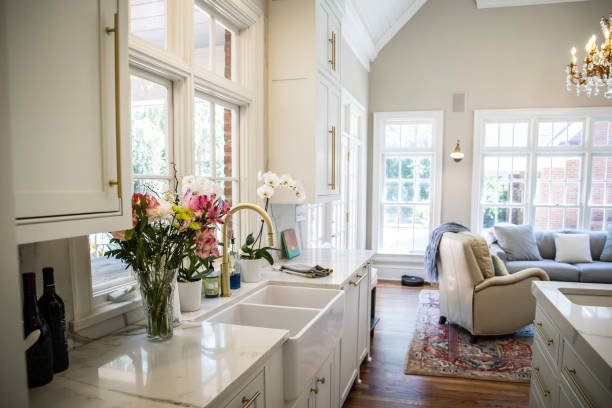
The Challenges of DIY
Although it is fun to try a do-it-yourself project, painting or putting up two-toned cabinets requires a lot of skill and finesse. It is difficult, especially, to achieve a flat and professional look unless one uses the necessary equipment and methods. Expect the two processes to be very time-consuming, and there may be a range of problems.
Benefits of Hiring a Professional
Hiring a professional to install comes with several benefits, such as consultation on the respective color and design and improved quality of work. Employing the services of experts in the field will be an added advantage since they have the experience and the right tools to do a neat job in the two-tone cabinet design.
9. Case Studies of Two-Tone Kitchens
Real-World Examples
- Urban Loft Design: An urban loft combines deep navy lower cabinets and crisp white upper cabinets. A sleek marble countertop and modern pendant lights enhance the contrast, creating a chic and sophisticated space.
- Farmhouse Charm: Soft green lower cabinets are paired with white upper cabinets in a charming farmhouse kitchen. Natural wood countertops and open shelving complete the look, adding warmth and a touch of rustic appeal.
- Coastal Vibes: A coastal kitchen design incorporates light blue lower cabinets with white upper cabinets. The beachy theme is enhanced by a white subway tile backsplash and driftwood-style flooring, creating a relaxed and inviting atmosphere.
Design Inspirations
Find more creation and inspiration in design periodicals, home redecoration blogs, and sites such as Pinterest. Commercial centers and design applications may also facilitate the attempt to make ends meet by simulating the appearance of various other color schemes and designs in the intended premise.
10. Common Mistakes to Avoid
Overcomplicating the Design
You should be very cautious when designing with many colors or patterns on a single product to avoid going wrong. It is always better to stick to a combination of simple and related colors so that everything will look in harmony. The two-tone cabinetry should be the show’s star without other surrounding features crowding it.
Choosing Incompatible Colors
You should also consider the colors you choose, which should harmonize with the colors selected in the kitchen. Before finalizing the purchase of the color samples, it is advisable to test them with the amount of light found in your kitchen. This is useful in simulating different potential conflicts and guarantees adequate visualization organization.
11. Expert Insights
Design experts suggest that two-tone cabinets work best when balanced with other elements in the kitchen. For instance, using a darker color on the lower cabinets can ground the space, while a lighter color on the upper cabinets can make the room more open. Consulting with a designer can help you navigate color choices and achieve a cohesive look.
12. Future Trends for Two-Tone Cabinets

Smart Technology Integration
Other possibilities for the further development of two-tone cabinets may involve the application of smart technologies. Some could be charging points, tap-less doors, or even smart controls for lighting, which would increase your kitchen’s functionality and elegance.
Eco-Friendly Materials
It can be noted that sustainable design is gradually being introduced into home design. Two-tone cabinetry will embrace even more eco-friendly options, including reprocessed timber and paints with low emissions of volatile organic compounds.
13. Practical Tips for Budget-Friendly Upgrades
Affordable Materials
For instance, when this is the case, one may opt for cheaper materials that look like the more expensive ones. This option involves the use of two colors, laminate, and MDF cabinets, and is relatively cheap as compared to the use of solid wood. However, the semi-custom or ready-to-assemble can be a more affordable option if one’s goal is within a tighter budget.
Small Changes for Big Impact
Of course, you don’t have to completely renovate the house, but small changes can be made as well. Fresh paint on old cabinets painted in two colors or changing the hinges on the cabinets are some of the techniques that can be used to change the appearance of your kitchen without stressing the wallet.
14. Conclusion
FAQs
[saswp_tiny_multiple_faq headline-0=”h3″ question-0=”What are two-tone cabinets?” answer-0=”Two-tone cabinets feature two different colors or finishes in a single kitchen. Typically, one color is used for the upper cabinets and another for the lower cabinets, or a contrasting island is paired with neutral cabinetry.” image-0=”” headline-1=”h3″ question-1=”What are the benefits of using two-tone cabinets?” answer-1=”Two-tone cabinets add visual interest and depth to your kitchen, break up monotony, and can alter the perception of space. For example, lighter upper cabinets and darker lower ones can make a room appear larger and more open.” image-1=”” headline-2=”h3″ question-2=”How do I choose the right color combinations for two-tone cabinets?” answer-2=”Consider classic pairs like navy blue and white or gray and cream for a timeless look. For a modern touch, try bold combinations like black and mustard yellow or teal and coral. Ensure the colors complement each other and fit with your kitchen’s overall design.” image-2=”” headline-3=”h3″ question-3=”Can two-tone cabinets be used in different kitchen styles?” answer-3=”Yes, two-tone cabinets can be adapted to various styles. In modern kitchens, use high-gloss finishes and bold colors. For rustic or farmhouse kitchens, opt for softer colors and natural materials. Transitional kitchens benefit from neutral tones and classic styles.” image-3=”” headline-4=”h3″ question-4=” Should I DIY or hire a professional for installing two-tone cabinets? ” answer-4=”While DIY installation can be cost-effective, it requires precision and expertise to achieve a professional finish. Hiring a professional ensures expert advice on color selection, design, and installation, leading to a high-quality result.” image-4=”” count=”5″ html=”true”]


